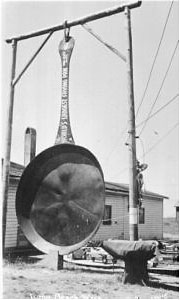What’s Cooking? – 2
More Thoughts on Prophetic Cauldrons
“Out of the frying pan into the fire.”
 The structure of Ezekiel follows the “soundwaves” pattern found in a great deal of the Bible, particularly the prophets. The Lord speaks His word as liturgy from the Most Holy Place, it is pre-enacted by the prophet in a new “Holy Place” (from outside the city – see Rags to Robes) in some terrifying judgments as object lessons (see Liturgy as Prophecy), and then the same judgments are played out in greater detail in the “Outer Court.” All three sections are heptamerous, and in these three areas we have Word, Sacrament (the prophet as a kind of new “acting” High Priestly mediator – see How to Read the Prophets), and Government.
The structure of Ezekiel follows the “soundwaves” pattern found in a great deal of the Bible, particularly the prophets. The Lord speaks His word as liturgy from the Most Holy Place, it is pre-enacted by the prophet in a new “Holy Place” (from outside the city – see Rags to Robes) in some terrifying judgments as object lessons (see Liturgy as Prophecy), and then the same judgments are played out in greater detail in the “Outer Court.” All three sections are heptamerous, and in these three areas we have Word, Sacrament (the prophet as a kind of new “acting” High Priestly mediator – see How to Read the Prophets), and Government.
The book of Ezekiel begins with this pattern, so we have the prophetic cauldron turn up three times. Each cycle takes us through the Tabernacle speeches (Exodus 25-31) which follow the Creation Week, so this is a process of new Creation for the anointing of Ezekiel and of de-Creation for the old Tabernacle of Solomon’s Temple. It was decayed and ready to vanish away.
Cycle 1 – Ezekiel 1-7 (Genesis)
Ezekiel sees a vision of the Lord’s chariot (Ark), falls down as dead (veil) and is raised up and given a job to (altar and table) [1] When we finally get to the laver (at Step 6: Atonement/Joshua), it is an iron griddle. Ezekiel has built a clay model of Jerusalem and the griddle, as the crystal sea, is a barrier between the judgments of the Lord and the rulers of the Land. The heavens are brass! Eventually, as we saw last time, incarnated in the Babylonian empire, the floodgates of the heavens would be opened upon the city. The sky would fall.
Cycle 2 – Ezekiel 8-11 (Exodus)
In the second cycle, Ezekiel, as priest, inspects the Temple (Lev. 13-14; Mark 11:15–19, 11:27–33; Matthew 21:12–17, 21:23–27; Luke 19:45–48, 20:1–8; John 2:12–25). This cycle follows the same pattern but in the Holy Place. Ezekiel is carried by the Ark-chariot from Babylon to Jerusalem. He prefigures Nebuchadnezzar! As a destroying angel, he digs through the wall (the veil) as a kind of un-Passover and exposes the sins of the priesthood. At Atonement, the six angels and the man in linen (the High Priest) rage through the city and slaughter the unmarked Israelites. Here, Jerusalem herself is the cauldron, and the rulers of the city thought they were the best meat in it! Clean sacrificial meat. But again, there was death in the pot.
Cycle 3 – Ezekiel 12-17 (Leviticus)
The third cycle is a de-Creation of the Tabernacle and priesthood. Because of the irreparable plague, the house would be torn down. It begins with Ezekiel’s prefiguring of Zedekiah’s doomed escape through a hole in the city wall. Step 1/Day 1 is always about light. Zedekiah lost his eyes in Babylon. The laver in this section is Ezekiel 16, beginning with the unwashed, abandoned child who became a harlotrous priesthood.
Cycle 3.5 – Ezekiel 18-24 (Numbers)
The final cycle leaves the greater pattern incomplete. It ends with the laver but in the wilderness, which makes the laver the pouring out of the curses of the Law instead of the blessings of the Spirit. The fire is on the outside instead of the inside.
Judah is again denied the perfect seven of Sabbath rest. Instead of the seventh feast, Ingathering, there is a Babelic scattering. Ezekiel scatters burning coals from the Altar over the city to consume the unfaithful priestly daughter. The Lord uses the rulers’ own metaphor of the cauldron to picture their destruction and purification by fire. He would tip out the old broth and boil the pot dry.
We saw that Babylon as cauldron was a laver. Here, Jerusalem is the laver. The laver, as firmament, is always an open scroll stretched across the heavens. It is a mediator, a Covenant that has a beginning and an end when the scroll-sky is rolled up (see In the Air). My point here is that the Davidic Covenant was coming to an end. Once Babylon was poured out as fire, young Daniel, a single man, would begin a New Covenant with the houses of Israel and Judah, fulfilling the words of Jeremiah. Babylon/Persia would become a new Tabernacle (Daniel 2), filled with water for the nations (Ezekiel 40-48). Just as Ezekiel became sacrament, the resurrected, united Jews would become a corporate mediator working as a priesthood within this greater Temple.
By the time of Christ, however, this Covenant, too, was ready to be rolled up. Jesus displayed a holy impatience for the process to be over with. He observed the injustices and abuses as the Son of Man, a new Ezekiel. With this background, depending upon one’s faithfulness to the Covenant, His words are perfectly terrifying.
“I came to cast fire on the Land, and would that it were already kindled!” (Luke 12:49)
______________________________
[1] For a full outline of Ezekiel using this method, get Totus Christus.

























